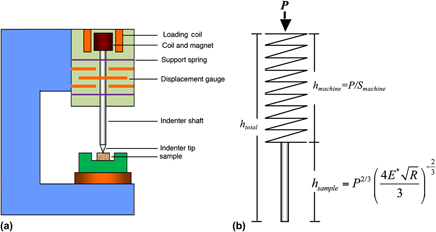Crossref Citations
This article has been cited by the following publications. This list is generated based on data provided by
Crossref.
Haghshenas, M.
and
Klassen, R.J.
2013.
Indentation-based assessment of the dependence of geometrically necessary dislocations upon depth and strain rate in FCC materials.
Materials Science and Engineering: A,
Vol. 586,
Issue. ,
p.
223.
Gao, Y. F.
Larson, B. C.
Lee, J. H.
Nicola, L.
Tischler, J. Z.
and
Pharr, G. M.
2015.
Lattice Rotation Patterns and Strain Gradient Effects in Face-Centered-Cubic Single Crystals Under Spherical Indentation.
Journal of Applied Mechanics,
Vol. 82,
Issue. 6,
Li, Weidong
Gao, Yanfei
and
Bei, Hongbin
2015.
On the correlation between microscopic structural heterogeneity and embrittlement behavior in metallic glasses.
Scientific Reports,
Vol. 5,
Issue. 1,
Gao, S. B.
Gao, Y. P.
Yu, P. F.
Feng, S. D.
Li, G.
Liaw, P. K.
and
Liu, R. P.
2015.
Dynamic Stress–Strain Behavior in ZrTiCuNiAl Noncrystalline Alloys Pretreated Under High Pressures.
Metallurgical and Materials Transactions A,
Vol. 46,
Issue. 6,
p.
2390.
Gao, Yanfei
and
Bei, Hongbin
2016.
Strength statistics of single crystals and metallic glasses under small stressed volumes.
Progress in Materials Science,
Vol. 82,
Issue. ,
p.
118.
Bei, H.
Xia, Y.Z.
Barabash, R.I.
and
Gao, Y.F.
2016.
A tale of two mechanisms: Strain-softening versus strain-hardening in single crystals under small stressed volumes.
Scripta Materialia,
Vol. 110,
Issue. ,
p.
48.
Xia, Yuzhi
Gao, Yanfei
Pharr, George M.
and
Bei, Hongbin
2016.
Single versus successive pop-in modes in nanoindentation tests of single crystals.
Journal of Materials Research,
Vol. 31,
Issue. 14,
p.
2065.
Lin, Hung-Yun
and
Gurrum, Siva P.
2016.
Global and Local Characterization of Passivated Aluminum Metallization Film for Extracting Elastoplastic Constitutive Model.
p.
766.
Meng, Liang
Raghavan, Balaji
Bartier, Olivier
Hernot, Xavier
Mauvoisin, Gerard
and
Breitkopf, Piotr
2017.
An objective meta-modeling approach for indentation-based material characterization.
Mechanics of Materials,
Vol. 107,
Issue. ,
p.
31.
Zhang, Wei
Gao, Yanfei
Xia, Yuzhi
and
Bei, Hongbin
2017.
Indentation Schmid factor and incipient plasticity by nanoindentation pop-in tests in hexagonal close-packed single crystals.
Acta Materialia,
Vol. 134,
Issue. ,
p.
53.
Yu, L.J.
Yen, H.W.
Wu, J.Y.
Yu, J.J.
and
Kao, C.R.
2017.
Micromechanical behavior of single crystalline Ni3Sn4 in micro joints for chip-stacking applications.
Materials Science and Engineering: A,
Vol. 685,
Issue. ,
p.
123.
Gao, Chenghui
and
Liu, Ming
2018.
Characterization of spherical indenter with fused silica under small deformation by Hertzian relation and Oliver and Pharr's method.
Vacuum,
Vol. 153,
Issue. ,
p.
82.
Jia, Haoling
Xie, Xie
Zhao, Lei
Wang, Jianfeng
Gao, Yanfei
Dahmen, Karin A.
Li, Weidong
Liaw, Peter K.
and
Ma, Chaoli
2018.
Effects of similar-element-substitution on the glass-forming ability and mechanical behaviors of Ti-Cu-Zr-Pd bulk metallic glasses.
Journal of Materials Research and Technology,
Vol. 7,
Issue. 3,
p.
261.
Jia, Haoling
Wang, Gongyao
Chen, Shuying
Gao, Yanfei
Li, Weidong
and
Liaw, Peter K.
2018.
Fatigue and fracture behavior of bulk metallic glasses and their composites.
Progress in Materials Science,
Vol. 98,
Issue. ,
p.
168.
Fang, Xufei
Porz, Lukas
Ding, Kuan
and
Nakamura, Atsutomo
2020.
Bridging the Gap between Bulk Compression and Indentation Test on Room-Temperature Plasticity in Oxides: Case Study on SrTiO3.
Crystals,
Vol. 10,
Issue. 10,
p.
933.
2021.
Testing of the Plastic Deformation of Metals.
p.
192.
Li, Weidong
Xie, Di
Li, Dongyue
Zhang, Yong
Gao, Yanfei
and
Liaw, Peter K.
2021.
Mechanical behavior of high-entropy alloys.
Progress in Materials Science,
Vol. 118,
Issue. ,
p.
100777.
Fang, Xufei
Ding, Kuan
Minnert, Christian
Nakamura, Atsutomo
and
Durst, Karsten
2021.
Dislocation-based crack initiation and propagation in single-crystal SrTiO3.
Journal of Materials Science,
Vol. 56,
Issue. 9,
p.
5479.
Li, Juan
Pharr, G. M.
and
Kirchlechner, C.
2021.
Quantitative insights into the dislocation source behavior of twin boundaries suggest a new dislocation source mechanism.
Journal of Materials Research,
Vol. 36,
Issue. 10,
p.
2037.
Zhang, Tairui
Li, Jianxun
Sun, Xun
Shang, Xiandong
and
Wang, Weiqiang
2022.
Improving the tensile property calculations with plastic zone radius measurements in depth-sensing spherical indentation tests.
The Journal of Strain Analysis for Engineering Design,
Vol. 57,
Issue. 7,
p.
513.





